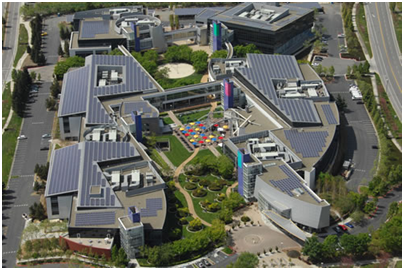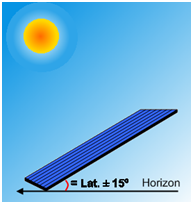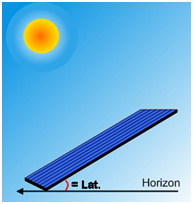Solar Power Basis - Solar Home
Solar Power is the electricity, which is obtained as a consequence of conversion of the solar irradiance. Sunlight, including ultraviolet radiation, can be converted into electricity either using the elements based on utilization the photovoltaics effect (PV – Photovoltaics) or by concentrating solar power (CSP - Concentrating solar power), using lenses or mirrors to boil water, which is then used to produce electricity, as well as in the technologies are based on utilization Stirling's engines.
Photoelectric effect and applications
A photovoltaic (solar) element is a semiconductor device that uses the property of light to create electric potential.
In 1887, Heinrich Hertz, during one of his experiments, noticed that some of the substances begin to emit free electrons, when exposed to ultraviolet light. Then, in 1900, the physicist Max Planck proposed the theory that light can only exist in the form of "packets" of energy, which later were known as photons.
The term "photon" (from the ancient Greek φῶς "light") was introduced by the American physical chemist Gilbert Lewis, who in 1926, in his work "The Conservation of Photons", hypothesized that the photon is a "new type of atom". Although this theory has never been recognized (being refuted by numerous experiments), the new name was immediately adopted by a majority of physicists.
In 1905, Albert Einstein evolved the theory of M. Planck. He postulated that the amount of energy in a photon is proportional to the frequency (color) of light and is expressed by the relation
E = hѵ, (1)
where E – energy; h – Planck constant (6.63*10-34 J•s), ѵ – frequency of light.
Any substance is characterized by the so-called "Work Function" - the energy required to release an electron. Electron can be released, if the photon energy (1) exceeds the value of "Work Function". The released electron acquires kinetic energy, which is equal to the difference between the photon energy (1) and work function, or
hѵ = E0 + Ek , (2)
where E0 – work function, Ek – kinetic energy of the released electron.
Therefore, the photoelectric effect depends on two factors: frequency of incident light and the work function of the material. For each material, there is a certain frequency (or, the color) of light, below which the electrons are not exempt, because the photon energy does not exceed the work function.
The photoelectric effect in a semiconductor material occurs when the photon can convey to a valence electron (electrons located on the outer, or valence shell of the atom) the amount of energy, enough to move it into the conduction band. The photovoltaic elements (generally called a solar cells) are being produced for many years and during this time, they have been greatly improved, as a result of the development of space technologies, where they are used as power sources for spacecraft, as well as for energy conversion.
At the same time, using of this technology in the Earth conditions has certain restrictions. Since the intensity of solar radiation is an unstable phenomenon and depends on factors such as seasons, weather conditions, transparency (dustiness) of air and daytime, to ensure uninterrupted electricity supply, electricity generation using photovoltaic panels is usually combined with the energy accumulation devices, or used in conjunction with other energy sources such as wind-, biomass- or hydro- generators. This allows the obtaining of 100% renewable (regenerative) energy.
Initially, photovoltaic cells have been used in such consumer products, as electronic watches, calculators and so on. Together with this, there are a lot of applications where solar cells are considered as the best alternative for electricity supply. Today, in light of improvement of the photovoltaic elements, the power generation technology by using solar cells, is getting more widespread. For example, in 2007, a well known company and search engine Google has completed a 1.6 MW solar installation at its headquarters in Mountain View, CA. It was the largest in the U.S. corporate installation at that time. Presently, this installation produces 30% of company's peak electricity demand in buildings powered by the solar panels, that is the equivalent of power consumption of approximately 1,000 homes in California.

Figure 1
The Solar Radiation's phenomenon in the wide sense, can be defined as the total spectrum of electromagnetic radiation emitted by the Sun. Annual average solar radiation or "irradiance" (in relation to solar radiation, it is also called "insolation" - from the term "incident solar radiation"), is expressed as the average irradiance in watts per square meter of surface (W/m2) or kilowatt-hours per square meter per day (kW • h/(m2 • day)). At the top of Earth's atmosphere, irradiance is approximately 1,366 watts of power per square meter (see Solar Constant ). When passing through the Earth's atmosphere, this value decreases. Thus, the level of solar radiation at the Earth's surface is reduced to approximately 1,000 watts per square meter for a surface perpendicular to the Sun's rays at sea level on a cloudless day.
The intensity of solar radiation depends on geographic latitude of given locality. Its value varies throughout the day, depending on season, air dustiness and weather conditions.
In the calculations of photovoltaic systems (PV), the total amount of solar radiation is expressed in hours of full sunlight intensity per m2, or in hours of peak sun "Peak Sun Hours". The average daily value of hours of peak sun is determined, either according to statistical data for the whole year or at the average statistics of the worst month. Thus, "Peak Sun Hours" - is an average number of hours in the day (for the entire year or worst month), when the intensity of solar radiation has been amounted to 1,000 W / m2 in an hour - 1 kWh/m2. For example, six peak sun hours means that the energy, obtained during all the daylight hours, is equal to six hours in a day, during which the solar radiation has been amounted to 1,000 W/m2, in other words - 6 kWh/(m2 • day).
The average value of Peak Sun Hours for your geographic region can be determined by using "Global Solar Power Map" (link will be opened in a new window).
Installation of solar panels
During the installation, the solar panels should be directed to the Solar South - in the northern hemisphere or to the Solar North - in the southern one (these directions are slightly different from the North-South direction of the magnetic compass). An installation angle of the panels dictated by the geographic latitude as well as by place where the system will be assembled. Typically, the angle of installation of solar panels is set within a range between latitude (Lat.) of the place plus 15 degrees, or latitude of the place minus 15 degrees, depending on the angle of inclination, which is more preferred for winter or summer time, in the given geographic region.

Figure 2
At the same time, it is possible to install the solar panels at the angle, which is equal to the latitude of given place, without seasonal changes in the angle of inclination.

Figure 3
Practical Part
As an example, let's take the town in Israel - Beer Sheva, (latitude for this town is 31.25º N). Then for this location, an inclination angle of the solar panel must either be equal to value of latitude - 31.25º or be in a range between 31.25º-15º=16.25º - for summer time and 31.25º+15º=46.25º - for winter time.
According to Global Solar Power map for this region, value of average annual Peak-Sun-Hours in a day is between 5.0 – 5.5 kWh/m2.

Figure 4
So, now we have two very important values - an Installation Angle for solar panels and number of Peak-Sun-Hours per day. Let's memorize these results, they will be required for further design and calculations.

